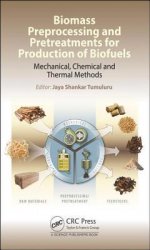Biomass Preprocessing and Pretreatments for Production of Biofuels: Mechanical, Chemical and Thermal Methods
- Добавил: koticvvik
- Дата: 15-12-2018, 21:20
- Комментариев: 0

Название: Biomass Preprocessing and Pretreatments for Production of Biofuels: Mechanical, Chemical and Thermal Methods
Автор: Jaya Shankar Tumuluru; J Richard Hess
Издательство: CRC Press
Год: 2018
Формат: pdf
Страниц: 471
Для сайта: vtome.ru
Размер: 12,11 МБ
Язык: english
Engineering the physical, chemical, and energy properties of lignocellulosic biomass is important to produce high-quality consistent feedstocks with reduced variability for biofuels production. The emphasis of this book will be the beneficial impacts that mechanical, chemical, and thermal preprocessing methods can have on lignocellulosic biomass quality attributes or specifications for solid and liquid biofuels and biopower production technologies. "Preprocessing" refers to treatments that can occur at a distance from conversion and result in an intermediate with added value, with improved conversion performance and efficiency.
This book explores the effects of mechanical, chemical, and thermal preprocessing methods on lignocellulosic biomass physical properties and chemical composition and their suitability for biofuels production. For example, biomass mechanical preprocessing methods like size reduction (which impacts the particle size and distribution) and densification (density and size and shape) are important for feedstocks to meet the quality requirements for both biochemical and thermochemical conversion methods like enzymatic conversion, gasification, and pyrolysis process. Thermal preprocessing methods like drying, deep drying, torrefaction, steam explosion, hydrothermal carbonization, and hydrothermal liquefaction effect feedstock's proximate, ultimate and energy property, making biomass suitable for both solid and liquid fuel production. Chemical preprocessing which includes washing, leaching, acid, alkali, and ammonia fiber explosion that can enable biochemical composition, such as modification of lignin and hemicellulose, and impacts the enzymatic conversion application for liquid fuels production. This book also explores the integration of these preprocessing technologies to achieve desired lignocellulosic biomass quality attributes for biofuels production.
Внимание
Уважаемый посетитель, Вы зашли на сайт как незарегистрированный пользователь.
Мы рекомендуем Вам зарегистрироваться либо войти на сайт под своим именем.
Уважаемый посетитель, Вы зашли на сайт как незарегистрированный пользователь.
Мы рекомендуем Вам зарегистрироваться либо войти на сайт под своим именем.
Информация
Посетители, находящиеся в группе Гости, не могут оставлять комментарии к данной публикации.
Посетители, находящиеся в группе Гости, не могут оставлять комментарии к данной публикации.
